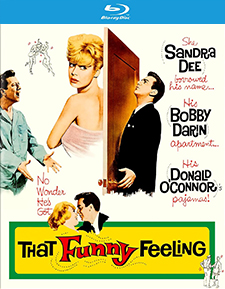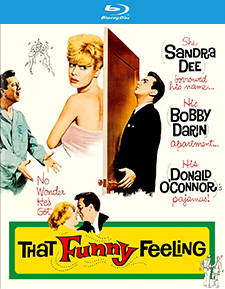That Funny Feeling (Blu-ray Review)

Director
Richard ThorpeRelease Date(s)
1965 (January 14, 2025)Studio(s)
Universal Pictures (Kino Lorber Studio Classics)- Film/Program Grade: B+
- Video Grade: A
- Audio Grade: A
- Extras Grade: B-
Review
An innocuous romantic comedy, That Funny Feeling (1965) came near the end of star Sandra Dee’s brief run as a major star, she having been a Top Ten box office draw during 1960-63. The screenplay by David R. Schwartz, a writer for the hilarious Amos ‘n Andy Show, is reasonably funny, with much double-entendre humor, at least as much as the waning Production Code would allow. The film generates some interest as mid-‘60s Hollywood studio product; it’s polished and efficient, but artistically way behind films being made simultaneously in Europe and Asia. Almost prehistoric in one sense, it’s one of the last gasps of the old-style big studio system.
The story is set in New York City, but this being a modest Universal schedule-filler, was filmed almost entirely on the Universal backlot (even the credits admit it was “filmed in Universal City”), augmented by Albert Whitlock matte paintings. Aspiring actresses Joan Howell (Dee) and girlfriend Audrey (Nita Talbot) work as maids to pay for their impossibly cramped apartment. Joan literally bumps into womanizing publishing executive Tom Milford (Bobby Darin, Dee’s husband at the time) no less than three times, the extended meet-cute third time happens when their respective taxis collide.
They begin dating, but because Joan’s so ashamed of her tiny apartment—so cramped it’s doubtful Tom could even squeeze inside—instead she becomes a squatter in a lavish apartment belonging to one of her housecleaning clients, its owner supposedly out of town for several weeks. What she doesn’t realize is that the apartment actually belongs to her new boyfriend, Tom.
Though Dee’s signature role was starring in the movie Gidget (1959), ironically made on a loan-out to Columbia Pictures, at Universal she mostly appeared in what could be described as second-string Doris Day-type romantic comedies. Day, also under contract at Universal, was the Number 1 box-office star in the U.S. in 1960 and 1962-64, concurrent with Dee’s peak years, and with Day in her middle-age (and older than she admitted to being at the time), the 20-year-younger Dee was something of an heir apparent. Indeed, That Funny Feeling, with the slightest of modifications could have worked as a vehicle for Day and, say, Rock Hudson, and may have even been written with those stars in mind. Darrin’s reactions to Joan commandeering his flat are especially Rock-like.
The picture is Carry On-lite with the sex humor, the Production Code on its last legs but still dictating terms. The climax (so to speak) of the movie has Joan punishing Tom for his womanizing by inviting all his ex-hookups, dressed up as prostitutes, to a party at his apartment. Or, at least, that’s the idea. In the movie she calls them “boulevard ladies” invited to a “Paris street party,” and one cop, eyeing the seemingly loose women converging on Tom’s apartment building, refers to them as “night flyers.” A running gag has a bartender (Robert Strauss), listening in on regulars Joan and Tom and imagining all sort of salacious goings-on while the other barkeep (Ben Lessy) reads the opposite into these overheard conversations, especially when Tom claims to be an interior decorator—get it? Other parts of the film are more conventional: a scene where Joan and Audrey try to make duck à l’orange with predictably disastrous results is something better suited to Lucy Ricardo and Ethel Mertz.
While the picture isn’t much more than a polished sitcom, populated mostly with predominantly TV actors, the film is handsomely made for its budget level and the actors are all good. Nita Talbot, Larry Storch (as an actor friend of Joan and Audrey), Leo G. Carroll (as an Irish pawnbroker), and Arte Johnson (briefly seen as a friend of Tom’s) were all on the cusp of TV roles that made them famous. Others like Herb Vigran (a bemused taxi driver), Larry J. Blake and Don Haggerty (as cops) and others were busy playing small parts in both TV shows and movies. James Westerfield, for instance, became known playing cynical policemen in Disney comedies of the period, and plays virtually the same part here. One brief scene involving a ruckus at a phone booth corrals Reta Shaw, Nora Malone, Kathleen Freeman, and Minerva Urecal, ladies who must have been up for the same roles for decades.
A somewhat nostalgic presence is third-billed Donald O’Connor, as another friend of Tom hiding valuable paintings in Tom’s apartment while he gets a divorce. Though best remembered for the MGM musical Singin’ in the Rain, O’Connor was in fact a longtime Universal player, from 1942-55, this being his first film for the company in ten years. The part seems written for another actor and not particularly suited to his talents, though he does do an impressive pratfall in one scene. The staging of that scene is botched, though, by journeyman director Richard Thorpe, That Funny Feeling being his penultimate feature. Though Thorpe helmed fairly big A-productions at MGM for decades, he was never better than routine, with no discernible style. Indeed, he was the original directed assigned to The Wizard of Oz but was fired after two weeks because his footage looked so lifeless.
Of interest to some is the film’s prologue, narrated by Paul Frees, essentially documenting cosmic accidents of one sort or another. Though no more than a handful of throwaway gags, the sequence includes a few moderately interesting special effects. Longtime effects cinematographer Clifford Stine was the film’s first unit director of photography.
Previously released to Blu-ray in 2021 by Universal itself, Kino’s new Blu-ray of That Funny Feeling offers an excellent video transfer of this 1.85:1 release. (Kino makes no mention of a new master, so I assume they use the same video transfer.) The image is impressively sharp with bright primary colors dominating, while the DTS-HD Master Audio (2.0 mono) is also quite good, and available with optional English subtitles. The disc itself is Region “A” encoded.
Extras consist of a trailer, in better shape than most Universal trailers from this period, complete with narration and text; and a new audio commentary by writers Julie Kirgo and Peter Hankoff. The latter is the type of lackadaisical track now dominating commentaries (especially on Kino titles) and which I personally find too casual and not very informative or interesting, especially when compared to the earlier days of commentaries on LaserDisc and DVD, when uninteresting tracks were the exception instead of the rule. These kinds of commentaries position the viewer as more of a passive participant at a watch party whereas I prefer tracks crammed with insightful, informative, and interesting information and astute observations.
For what it is That Funny Feeling proved more entertaining than I expected it to be, and the dated but still-impressive studio shine given the picture combined with its talented cast kept me engaged throughout. Not bad.
- Stuart Galbraith IV

